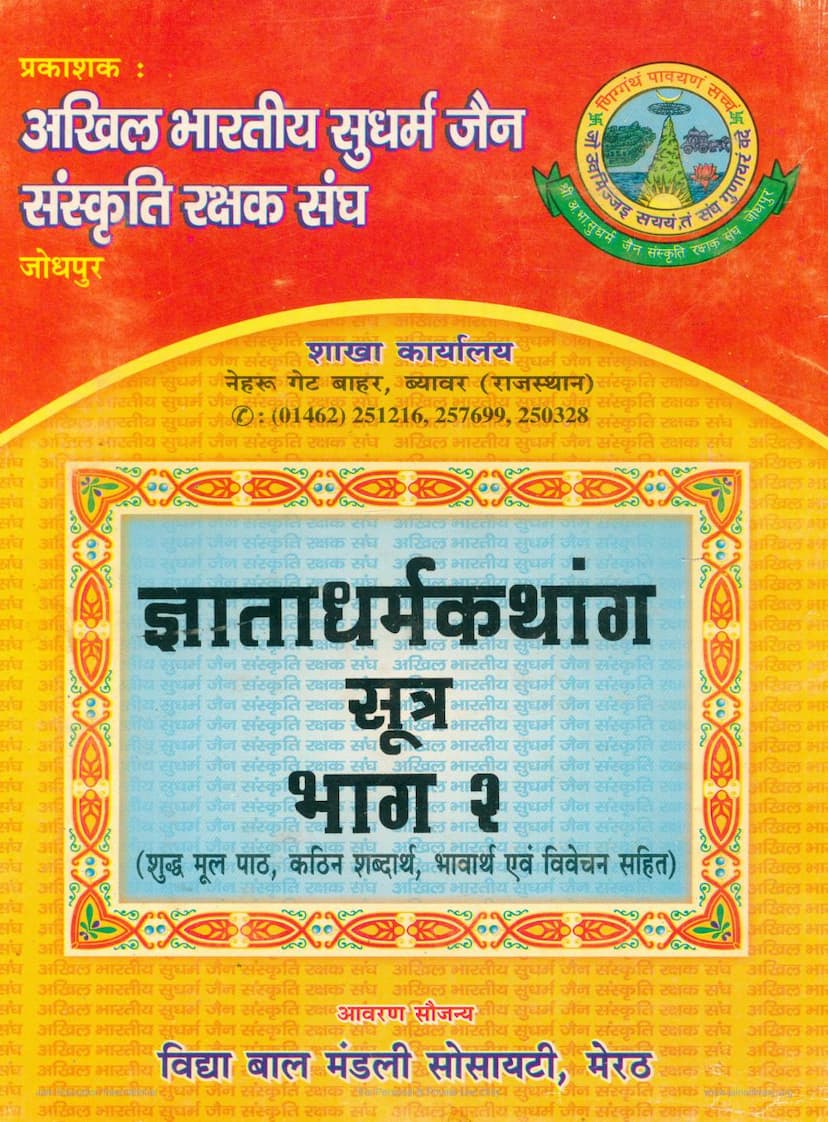Gnata Dharmkathanga Sutra Part 02
Added to library: September 1, 2025

Summary
Certainly, here is a comprehensive summary of the provided Jain text, "Gnata Dharmkathanga Sutra Part 02":
Book Title: Gnata Dharmkathanga Sutra Part 02 Author(s): Nemichand Banthiya, Parasmal Chandaliya Publisher: Akhil Bharatiya Sudharm Jain Sanskruti Rakshak Sangh Summary:
This volume, "Gnata Dharmkathanga Sutra Part 02," is the second part of the Gnata Dharmakathanga Sutra, a significant Jain scripture. It contains studies from the 6th to the 16th, along with the second Shruta Skandha. The work is presented with the original text, explanations of difficult words, a summary of the meaning (Bhavarth), and detailed commentary (Vichana).
Key Themes and Content:
The Gnata Dharmakathanga Sutra, as a whole, falls under the category of Dharma Kathaanuyoga (narrative of righteous conduct) within Jain Agamic literature. It is renowned for its profound stories and dialogues that illustrate Jain principles and philosophy. Part 2 continues this tradition, offering insights into various aspects of spiritual discipline and the consequences of actions.
Summary of Key Studies (Adhyayanas 1-19):
The provided text details the essence of nineteen specific studies within this part of the Sutra. While a full summary of each study would be extensive, the key themes and lessons are highlighted:
- Spiritual Discipline and Inner Transformation: Many studies emphasize the importance of inner resolve, detachment, and perseverance in the face of hardship. The initial chapters, like the first study on Meghakumara, illustrate how understanding past lives and the true nature of suffering can lead to steadfastness in spiritual practice.
- The Importance of Right Faith and Attitude: The third study highlights how faith in the Tirthankaras' teachings and the avoidance of doubt (Shanka, Kanksha, Vichikitsa) are crucial for spiritual progress. The story of Jinadatta and Sagardatta demonstrates the detrimental effects of doubt versus the benefits of faith.
- Control of the Senses: The fourth study uses the analogy of tortoises to explain the necessity of controlling the senses (Indriya Nigraha) for spiritual aspirants. The inability to control senses leads to downfall, while their subjugination leads to liberation.
- Overcoming Laziness and Re-dedication: The fifth study, featuring King Shailek, illustrates how even after falling into laxity, one can re-awaken their spiritual fervor and achieve the ultimate goal through sincere effort and guidance.
- Understanding Impermanence and Karma: The sixth and seventh studies, through examples like the gourd and the story of Dhanya Sarthavah and his daughters-in-law, emphasize the impermanent nature of worldly possessions and the importance of righteous conduct and adherence to vows.
- The Impact of Actions and Character: The eighth study, featuring Mallinath Bhagavan and the lay disciple Arhanaka, underscores that actions (Karma) are impartial and their consequences, whether positive or negative, are inevitable. It also highlights the power of devotion and adherence to principles.
- The Dangers of Indulgence and Neglect: The ninth and tenth studies warn against the pitfalls of sensual indulgence, lack of control over desires, and the consequences of deviating from the path, as seen in the stories of the merchants' sons and the lunar phases.
- The Virtue of Tolerance and Equanimity: The eleventh study, using the example of coastal trees, emphasizes the virtue of tolerance and equanimity (Sahanshilta) in the face of criticism and adverse situations.
- The Nature of Matter and Transformation: The twelfth study delves into the principles of Pudgala (matter) and its transformative nature, suggesting that what appears good or bad is subject to change and perception.
- The Influence of Association and Attachment: The thirteenth study highlights how good association fosters spiritual growth, while bad association and attachment lead to downfall. The story of Nand Manikar illustrates this point vividly.
- The Whimsical Nature of Karma and the Power of Good Company: The fourteenth study, through the tale of the Tetli-putra and Potilla, demonstrates the unpredictable nature of karma and how good company and righteous teachings can lead to enlightenment.
- The Perils of Sensory Pleasures: The fifteenth study, using the metaphor of the Nandi fruit, warns against the deceptive allure of sensory pleasures, which can be fatal if one is not mindful.
- The Long-Term Consequences of Actions: The sixteenth study, beginning with the life of Nagashri (who becomes Draupadi in a later life), illustrates the profound and far-reaching consequences of actions, particularly the harm caused by offering unwholesome food to ascetics and the importance of righteous living.
- The Power of Detachment and Self-Control: The seventeenth and eighteenth studies, through the analogy of horses and the story of Dhanya Sarthavah's daughter Susumma, emphasize the significance of detachment from worldly desires and the importance of self-control in overcoming obstacles.
- The Path to Spiritual Upliftment and the Pitfalls of Attachment: The nineteenth study, with the story of King Mahapadma's sons Pundrik and Kandrik, provides a stark contrast between spiritual aspiration and attachment to worldly pleasures, highlighting how the former leads to liberation and the latter to downfall.
Second Shruta Skandha (Dharma Katha):
The second Shruta Skandha is dedicated to "Dharma Katha" (tales of righteousness) and is divided into ten "Vargas" (classes or sections). These Vargas cover various celestial beings and their consorts, illustrating different facets of life and the consequences of actions, often leading to spiritual awakening or downfall. The first Vargas, "Kali," introduces the concept of a Devi's existence and her previous life, setting the stage for subsequent narratives that often follow a similar pattern of worldly life, spiritual realization, or the impact of karma.
Overall Significance:
This volume serves as a guide for spiritual seekers, offering practical lessons derived from the lives of various individuals, both human and divine. It underscores the Jain principles of karma, non-violence, detachment, faith, and the pursuit of liberation through righteous conduct. The stories are designed to illustrate complex philosophical concepts in an accessible and engaging manner, promoting moral reflection and spiritual growth. The text also provides detailed explanations of difficult terms, making the profound teachings of Jainism understandable to a wider audience.